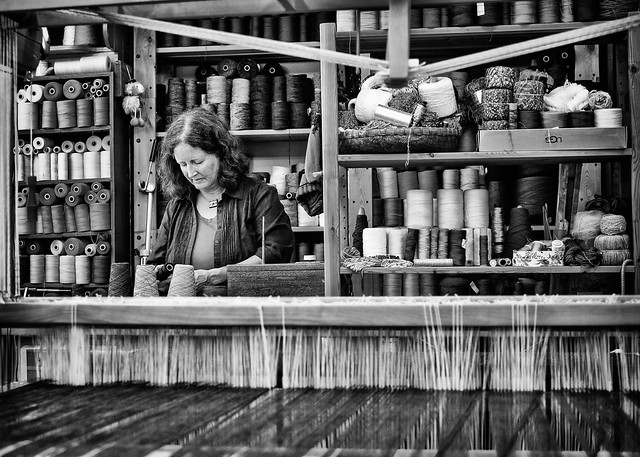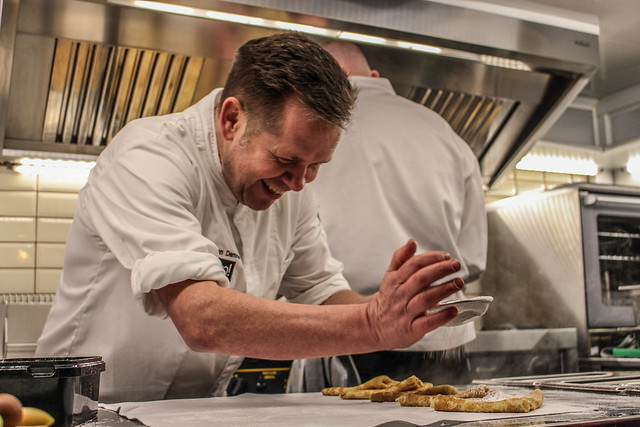Unlock the Magic in Your Story Now
Get the Free 20 questions to Ask Before Launching Your Idea workbook when you sign up for occasional updates.
Get the Free 20 questions to Ask Before Launching Your Idea workbook when you sign up for occasional updates.
Articles filed in: Strategy
Thank You For Your Work

Every day, we are served and nourished by others. We are supported and guided or empowered and inspired by people who have no idea how much they helped us.
What kind of companies would we build if happy, grateful customers were our goal?
What would it take to empower more customers to say thank you and mean it?
What if we created a culture that meant more people heard that their work mattered?
What difference would connecting our effort to its impact have on each and every one of us?
We can be more grateful customers and build the kind of organisations that create them on purpose.
Image by Garry Knight
Your Company Needs A Strong Strategic Narrative
filed in Storytelling, Strategy, Success

A strategic narrative is the story that drives the choices a company makes. That narrative is the thread from which the company’s fabric—its culture and strategy are woven. Sometimes the story accidentally informs the strategy with unintended positive or sometimes, negative consequences.
It stands to reason then that we can and should intentionally leverage our narrative to achieve greater alignment and success.
The elements of a strong strategic narrative
1. Mission
Having a strong sense of purpose.
2. Values & Vision
Knowing who you are, what you stand for, who your best work is for and where you’re headed.
3. Value Creation
Understanding who your customers want to become in the presence of your product.
4. Capability
The ability to align and deliver on 1, 2 and 3.
A strong strategic narrative enables us to prioritise the opportunities, plans and behaviours that align our vision and values with our customer’s unmet needs.
Yes, we tell our story, but the story also tells us.
*Want to explore your company’s strategic narrative in more depth?
My book Story Driven will show you where to begin.
Image by Joris Louwes
Good Stories Drive Great Strategy
filed in Storytelling, Strategy

Good stories have always driven great strategy—not the other way around.
Companies forgot this in the golden age of advertising when they began asking ad agencies what they could say to sell more products, instead of first understanding what they must say to show who they were and what they stood for.
Successful brands have a great story long before they have a grand plan.
Image by Alice Donavan Rouse
The Power Of Brand Energy
filed in Storytelling, Strategy

Weekends are a quiet time for the two chocolate shops at the ‘Paris End’ of Melbourne’s Collins Street. During the working week, they are busy serving office workers who meet for coffee, buy gifts or want a little treat with their morning tea. On Sundays, the pace is much slower. A handful of tourists and window shoppers wander in and out to browse and enjoy chocolate samples.
It’s a good time to restock and get the shop looking good for the week to come. When it’s quiet, both shops are staffed by one or two people who are responsible for the entire customer experience. The energy they bring to their work on Sunday carries the brand.
The manager at the first shop enjoys the leisurely pace of Sundays. So much so that he sighs when customers ask questions or change their mind and looks for an excuse to close the cafe early so he can get away on time. The young girl at the second is excited to hand out free chocolate samples. She delights in telling customers about new flavours and marvels at the colours of the packaging and that the Easter eggs are all hand-wrapped.
Her eyes light up when she talks about the man—she describes as the company’s own Willy Wonka, who sits in a little office at the factory in Adelaide filled with ingredients and spices, inventing new flavours all day. ‘It’s not hard to be passionate about chocolate,’ she says. As she carefully wraps small packages.
The difference between the manager in the first shop and the sales assistant in the second is easy to see and hard to account, let alone hire for. That difference is purely the energy they bring to their work.
Brand energy builds brand equity. Passion isn’t something you can fake. It’s impossible to instruct. But when you have it people know. And when you experience it, you return to its source.
Image by Matthew
Build Your Darlings

It’s often said that you should kill your darlings. This sentiment was first expressed by British writer Arthur Quiller-Couch in 1914 when he cautioned writers not to fall in love with their prose at the expense of the reader. Here’s what he said.
‘Whenever you feel an impulse to perpetrate a piece of exceptionally fine writing, obey it—whole-heartedly—and delete it before sending your manuscript to press. Murder your darlings.’
Quiller-Couch’s words are sometimes taken to mean that you should never fall in love with your ideas. But if you want to do work you’re proud of what alternative do you have? You must believe your work can change things for the better. I think what these words wisely caution us against is simply falling in love with the work itself, instead of being passionate about the change we hope to make.
So go ahead, build your darlings for the people you care about serving. Those people who will fall in love with how your work enables them to live the lives they want.
Image by Darwin Vegher
Try Anyway

Texas head teacher, Belinda George, doesn’t have access to more resources than her colleagues. So how does she change her students’ lives for the better? Instead of focusing on the things she and her team can’t control, like educational policy and budgets, she concentrates on the things she can influence.
Ms George is then free to show up as herself, own her story and ask; what can I do to make things better? Her goal is to bridge the gap between school and home, deepening the school’s relationships with the children and their families.
The result is ‘Tucked-in Tuesdays’—a weekly bedtime story reading broadcast to her ‘scholars’ via Facebook live. Belinda George didn’t wait for the data to tell her what she already knew in her heart was the right thing to do.
Too often we get caught up looking for certainty about a likely outcome before being willing to try. Many breakthrough innovations and life-changing initiatives were brought about by people who didn’t know for sure, but who tried anyway.
Go ahead, try anyway. What have you got to lose? Or even better, what does the world stand to gain because you did?
Image by Austin Public Library
Everyone Speaks

If you search ‘best breakfast in Hobart’ on Trip Advisor, you’ll find a tiny, backstreet cafe in the number one spot. This cafe opens for six hours each day, only seats a dozen people and has a queue of eager diners waiting outside before it opens. It’s the kind of place the people who visit go out of their way to find.
What’s the big draw? The cafe is designed so diners can sit at the bench and interact with the chef while he cooks their delicious breakfast. People are not just going to eat amazing food. They’re coming for the theatre and the feeling of intimacy.
The chef is the star of the show. But it’s not just the chef’s performance that matters. How every member of the team welcomes and serves people makes or breaks the experience. Everyone’s actions speak for the brand. So when the waitstaff don’t smile or scold diners for moving into their workspace, it breaks the spell and kills the magic.
Everyone, no matter how visible, who has a hand in creating the customer experience, speaks for your brand. It isn’t only the star of the show who tells the story.
Image by Marchaud Wittouck
Sweeping The Floor
filed in Strategy

One of my first jobs was in the hospitality industry. We worked long hours, weekends and holidays for average pay. Staff turnover was high. It was hard for managers to motivate people. One of our best managers didn’t bark orders about smiling at customers or showing up on time. She led by example.
The first thing Paula did when she arrived every morning was sweep the floor. Sweeping the floor became a ritual—her way of preparing a welcome for customers when they arrived. That small act changed Paula’s posture, as well as the attitude of the team who worked with her.
When we sweep the floor we’re not only showing our customers that we care about their experience, we’re reinforcing our values to ourselves and others. Paula believed serving customers was a privilege, not a chore. She showed us that while we couldn’t always choose our working conditions, we could always choose our attitude.
Sweeping the floor rarely counts as a core business activity—not in the way buttering the bread, speaking to customers and taking the money does. But when we care, our customers know. They don’t just see it in how well the product or service works—they sense it in everything we do.
Image by Ruby
On Culture
filed in Storytelling, Strategy

Culture is how we act, based on what we know about who we are.
It isn’t about fitting in, it’s about understanding where we belong and why.
Culture is a reminder that if we believe this, then we do or don’t do, that.
It’s about saying this is who we are, then living up to that ideal.
The leader’s job isn’t to tell us what to do.
It’s to remind us who we are, so we can live that story.
Image by Michael Dawes
Prices Are Stories

The difference between an $800 pair of Jimmy Choo sandals and those you can buy in Target for $20, isn’t only the quality of the materials. The prices we pay or charge are not just stories about value. They are stories about intentions and expectations—not just on the part of the customer, but also on the vendor.
Customers make assumptions about what they’re buying based on what they pay, and sellers make assumptions about the kind of customers they will attract with a particular pricing strategy. But price alone is a crude way to sort your right customers from your wrong customers.
Just because someone has the money to pay what you’re charging, doesn’t mean they’re your ideal customer. If you get to choose what you work on or make, you also get to decide who to serve.
What are your criteria for choosing the customers and clients who allow you to do your best work, and make it joyful into the bargain?
Image by Steven Guzzardi